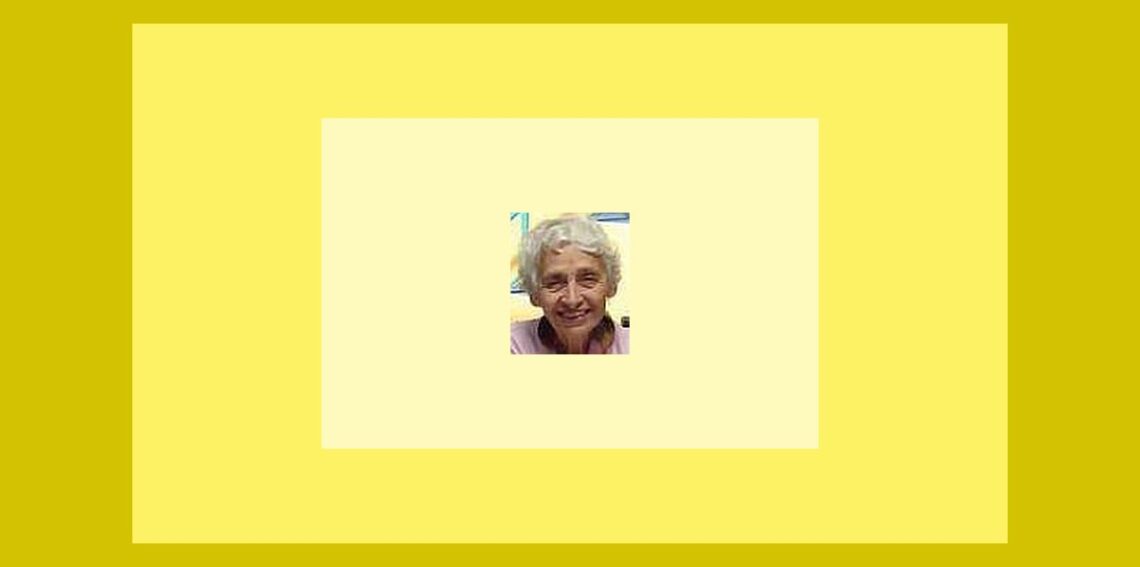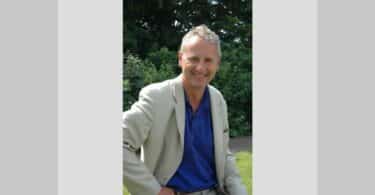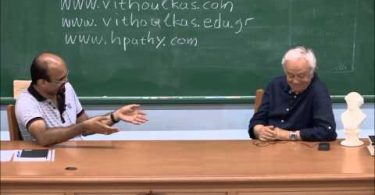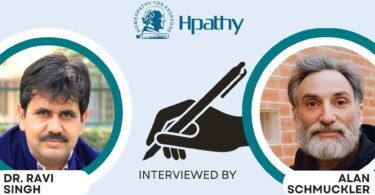Today we have the pleasure to have with us Dr. SML Fayeton who is a medical doctor and homeopath in France.
E.D.B.: Welcome to the Hot-Seat of Homeopathy for Everyone. We have already enjoyed three of your cases published in previous editions of the magazine *. In these cases we discovered an approach to the patient which is slightly different from what we are accustomed to in the English speaking homeopathy world. The reason for this appears to be your interest in the work of Dr. Elizalde Masi, mixed of course with the cultural differences between English and French speaking communities.
You were initially trained by “French” pluralist homeopaths, but you said that very soon you were prescribing only one remedy at any time. Can you tell us about your evolution as a homeopath?
SML F.: Right from the beginning when I was taught “French pluralism”, for me it was just obvious to prescribe only one remedy at one time. Homeopathy can only be unicist. When a fever is Belladonna, how could it be Ferrum phos or Aconite? I immediately understood that people used several remedies at one time due to laziness.
When I was in Rwanda, I had a collection of remedies in 5CH only. A young Rwandese girl prepared 7C, 9C and 30C from these dilutions by diluting and succussing them further. When I did not know what remedy to use, I used allopathic medicines. This allowed me to know where I was with my prescriptions.
When I met Dr. Mureau in Brussels, he gave me the tools to progress in the unicist way by introducing me to the “Broussalian”, a translation of Kent in French. The repertory of Kent was unfamiliar to the French homeopathy teachers of that time. Then, Dr Schmitt made me read the Organon and the works of Kent.
My contact with Dr. Masi allowed me to discover Ghatak, and the coherence that exists between the central hypothesis of a remedy and the symptoms of this remedy. This new way of studying remedies immediately improved the results for my patients.
This new way of studying remedies has set me off on a long and difficult adventure of progressing in homeopathy, but it is intellectually satisfying. So, I learned from teacher to teacher.
E.D.B.: When you worked in Rwanda you chose to use conventional medicine when you were not sure about your prescriptions. From your cases published in this magazine, it is clear that you still rely to a certain extent (referral to consultants) on conventional medicine. Can you tell us more about how you perceive the relationship between homeopathy and conventional medicine?
SML F.: When I worked in Rwanda, I was learning. I found out that people healed faster with homeopathy than with allopathic treatment. Nowadays I rarely use conventional medicine. In my opinion, both medical techniques have their role to play.
Allopathic medicine is useful when we have no better solution for the day to day management of man’s suffering, because of a chronic or a temporary deviation of their vital energy. Homeopathy is useful to re-establish a healthy balance in the vital energy, which is the real definition of “bringing back to health”, so the patient doesn’t need allopathic medicine.
The value of modern medicine is in its capacities of diagnosis and imaging. On the downside there is a risk of it becoming a terrorist occupation making the world’s population live in fear through its early diagnosis campaigns by making people conscious about their illnesses years before they become apparent, often without any hope for effective treatment or cure. People are not allowed anymore to be in peace, enjoying an apparent state of health. They are often forced into becoming the objects of treatments and care until death follows. Whatever we do, death will arise anyway.
Even in homeopathy we cannot guarantee a cure. Only on some occasions, due to good luck or an efficient use of the Masi hypothesis, can we find a perfect simillimum for a patient which will allow perfect cure. In many other cases, the work of the homeopath and the patient is a work in progress, possibly through the prescription of a number of remedies.
E.D.B.: For the sake of argument, one could say that prescribing a succession of remedies is a form of pluralism.
SML F.: I would not call this pluralism when the aim is to prescribe only one remedy at a time. The remedy may then allow one to discover something new, a new perception, something more specific leading to a new (better?) remedy. During this difficult process, we help the patient to progress towards a better level of health all through ups and downs, even when there is no rapid, smooth, perfect and definite cure according to the wishes of Hahnemann, who himself did not always obtain such a perfect result.
Being a unicist is a way of approaching the patient. It is about prescribing based on the totality of the content of the case and not only by using the symptoms of the present.
Yesterday a patient called me. She was panicking. She suffered with a peri-arthritis of the shoulder. My remedies had not had any effect. She was given cortisone treatment. She also suffered a short bout of blurred vision. An MRI was performed. She was diagnosed with multiple sclerosis. After a mammography she was told she had a cyst which the doctors wanted to sample because it may be cancer.
I revisited her file from all angles and could not think what other remedy to give. I rang her and said her: “I cannot understand your case.” She replied: “It is not your fault, I did not tell you my whole story. I told you I was happy with my new friend but I was deluding myself. I now regret the man I left to live with him.” The consultation lasted another hour and I have given her a new remedy.
E.D.B.: Your answer is an illustration of how difficult homeopathy really is. This brings me to the following observations: A number of patients will give up homeopathy if they don”t perceive any immediate success. Many homeopaths perceive the use of conventional medicines as very toxic or even suppressive making further homeopathic prescriptions even more daunting.
Should we reach for homeopathy prescriptions and techniques that advertise a more reliable success rate and/ or try to rely purely on “natural” treatments to “bridge” between the first contact with the patient and the time of the first ‘successful” homeopathic prescription (as perceived by the patient/client)? You mentioned how the study of the “central delusion” is a demanding technique. Demanding usually means difficult. Are there different types of homeopathy that can be practiced at different levels?
SML F.: Of course, one can practice homeopathy on different levels. This is what Dr. Masi said: “The first level concerns the organic plane; the level of the lesion. The second level concerns the combination of the hierarchised symptoms. The third level looks out for the leitmotiv, the being of the patient. The third level is all that drives the patient in his/her choices and engagements throughout life which has its similarity in the hypothesis of the essence of the remedy. The essence is not a global impression of the remedy or something that has to do with the symbolism of the remedy, it is the result of the thorough study of the pathogenesis of the remedy.
To practice on the level three, for a follower of the technique of Masi, all prescriptions are based on the totality of the patient. In many cases we only perceive a part of this reality (totality). This partial similarity is often sufficient to achieve a deep action on the patient through the remedy. This gives us confidence in our prescriptions.
It is unusual for a case which has been thoroughly researched by the practitioner, not to benefit from the prescription(s). The effort of the practitioner will sustain the patient, who then will want to continue to collaborate towards a cure.
Of course during this collaboration we can count on the patient’s patience through our interventions which procure some relief, knowing that we will do better as soon as this is possible.
Many patients feel well and are satisfied to come and “collect their dose” every two or three months, when a previous prescription appears to have lost its effectiveness. And one day, after having read or studied a remedy, one suddenly realises the patient is a Mr. or Mrs. so and so and therefore receives the remedy that covers the 3rd level. After this, the patient will return less and less to see the homeopath and will enjoy a stable health. This can be a simple singular symptom that points to a remedy for which there is no or only an incomplete hypothesis.
I remember a patient, who was a grand-mother. Throughout her life she had been treated with homeopathy. Her homeopath passed away and she came to see me. She did well until she was 80 years old. At that point, a cardiac insufficiency declared itself. I give her heart treatment and explained to the family the seriousness of the situation.
Then one day she told me a dream: Everything was dirty, she cleaned everything; remedy: Curare. She made a full recovery. I stopped the heart treatment and she lived until the age of 103, in a village in the mountains serving the community as well as she could. She was so well psychologically that she attracted all the young people who enjoyed visiting her, seeking her wisdom.
When she was 103, her family decided she would be better in a home. Arriving there she was vaccinated against flu, which caused a flu-like condition which proved fatal. But then 103 years old is already quiet good.
I would like to cite Nestor Godoy who was Dr. Masi’s pharmacist for 30 years, when he presented a case of a centenarian who died during treatment by Dr. Masi :
“Death doesn”t need to be a frustration for the doctor, but can be seen a success because he/she helped the patient to enjoy the maximum of their talent, both physical and spiritual, during each life stage. When life comes to an end, the function of the doctor ceases, not in the sense of a failure but a satisfaction of mission accomplished both from the point of view of the doctor and the patient.”
Of course, this was a centenarian, but I think this applies to all cases where a conscientious doctor did all he/she could for the patient, even when this patient was very young. I remember very well two patients who came to me in an advanced stage of cancer with metastases, who I managed to help for one year. They both told me in the last month of their lives: “I live the best part of my life, there is so much love around me.”
Of course they both talked about the love of their family and friends but also referred to the “divine” love. This humbles the doctor and makes one think about what is the real euthanasia or the “good” death.
E.D.B.: The good “euthanasia”, indeed the death that comes in peace is one of the great things homeopathy has to offer.
You were very generous in allowing me to translate into English a synopsis of Dr. Masi’s work and philosophy produced by the AFADH which is published in this edition as a separate article. How much different is Dr. Masi’s work from many of the other prescription techniques practiced in today’s homeopathy world? Is there a possibility that the different approaches presented by various schools will finally come to a “unified” technique, or will cultural and language differences and the need for patient/client satisfaction stop this from happening?
You wrote to the editor of the magazine about how close Ananda Zaren and Dr. Masi were in their conceptions of homeopathy.
SML F.: I am very much interested in Ananda’s conceptions, they are very close to Dr. Masi’s ideas. The Wound is the Vulnerability. The Wall is the Egotrophy. The Mask is the “hidden” Egotrophy. Dr. Masi added the egolyse (the failure of the Wall) and the heterolyse (the Vengeance).
Dr. Masi was the first to search for the essence of a remedy by using a systematic methodology. Others have searched for and proposed methods that have a more appealing mechanism. Some have resorted to the pre-Hahnemann theory of signatures, looking for an aspect in the nature of the substance to support a hypothesis of the remedy. Dr Masi is not opposed to any of these techniques, he wished there were botanists, zoologists (in France we are lucky to have Dr. Agnes Flour) and mineralogists amongst homeopaths to improve understanding of the proved substances.
He deemed that the “exterior” study of the substance teaches us only little about its essence in comparison to its proving. In the proving, the symptoms of the remedy manifest themselves in the words of the experimenter. It is his opinion that the hypothesis of a remedy should be built on the experimenter’s words and only then can it be compared to the nature of the substance to find a coherence.
The modern homeopathy schools are also looking for an intellectual order in the large number of remedies possible. They use a horizontal classification system. Jan Scholten searches to increase the knowledge on metals through the periodic table. Rajan Sankaran classifies the elements of creation through botanical, zoological and mineral criteria based on elements from the pathogenesis. For example: Thuya feels fragile, so he will verify whether all conifers feel fragile.
It appears to me that the search for the sensation according to Sankaran’s concept is not far removed from the way Masi interrogated his patients: he continued until he obtained the precise symptom by asking repeatedly: Porque?, para que? (Why? What for?).
The horizontal classifications are of great interest for the future of homeopathy and are not opposed to Masi’s work. Dr. Masi brought us an original vertical classification system; he looks in each remedy for the metaphysical conflict that is the source of all pathology and all the symptoms in the pathogenesis under the influence of the particular energy proved.
He classifies remedies according to the Divine perfection longed for: the Divine intelligence, the Divine providence, the Divine immutability, the Divine eternity, etc. within the subgroups for each Divine perfection longed for, its particular aspect. He succeeds in Hahnemann’s dream of uniting all diseases into one: psora: the imbalance of man who wishes to play God in one particular aspect or suffers of not being this aspect (inferiority complex?).
Dr. Masi said: “Those who wish to study the drama of men without discovering the metaphysic aspect of this drama are naive.”
Those who have not embraced Masi’s method perceive it to be very intellectual, even hazy, without any interest for their practice. Nevertheless, every time I hold a seminar on the Masi method, my colleagues are surprised and tell me “but this is very useful for our daily homeopathic work!”
Dr Masi taught us to read the pathology of the mental attitude using the Aristotle-Thomism reference to help in answering the following questions: What is the purpose of this function? Is it used by the patient in its natural purpose?
What is thought? What is its purpose?
Nux Vomica is sensitive to injustice. What is justice, what are its deviations, it pathologies, etc?
Coffea is charitable. What is charity, what are the deviations of charity, what are the pathologies of charity? Can there be excess in love or service, can there be a deviation in the way of loving or rendering a service?
Aloe wants to reconcile. What is reconciliation, how can the desire for reconciliation be pathologic?
Masi said: “One cannot imagine a surgeon who does not start by studying the normal anatomy before working on the deformations”. The doctor who wants to work on the mental symptoms has to learn in an objective way (not through the vision of his/her own psoric tendencies) “the normal anatomy” of passions, virtues and human activities in general. He could not find a more precise and profound research than the Aristotle “Thomism thinking which are found in the writings of Thomas d’Aquin.
All these finding by homeopathy researchers have their place and one day, I think, will find their unity. But it is logical to think that the noumenal homeopathy by Dr. Masi will embrace this unity because it touches on the most profound of disease in man. When? Masi thought it would be in the 4th millennium.
I think that the progress of homeopathy is so great everywhere that I have good faith in it happening in the 22 century.
E.D.B.: We thank you very much for sharing these very revealing thoughts and experiences of homeopathy with us. We are also grateful that you helped us in making some of Masi’s work available to the English speaking community.
There may be readers who would like to find out more about Dr. Masi’s work. Is there somewhere they can go?
SML F.: In September 2009 we have our yearly congress. (10-13 September) The group will be very international with people coming from Russia, Poland, Brazil, Argentine and other places. They all bring their translators and there is room to constitute an English speaking party as well. The congress is held in a lovely setting: Le Domaine de Chadenac, 43000 Ceyssac in France. Masi’s work and approach of remedies is discussed through the presentation of cured cases brought by participants.
For more information write to: l’AFADH, Le Clos de Corsac, Bât les marronniers, 43700 Brives Charensac, France Tel ++ 33 4 71 02 92 98 or Email: [email protected]
E.D.B.: I will be there and will assure translation to English if this is required.
——————————————————-
Edward Debeukelaer
homeopathy for the patient behind the symptoms.
[email protected]
——————————————————-
Addendum: Dr. Fayeton Discusses Her Method ” A brief correspondence
10300 and Other Unusual Dilutions Used by Dr. Fayeton
I had the pleasure of translating a few human cases that were sent to me by Dr SML Fayeton. I then discovered that she uses dilutions like 12000, 10300, 15000, 21000, 1001 and 12001.
It is unusual to come across these types of dilutions so I asked her what they referred to. This is her response;
Much of my homeopathy technique is based on the study and teachings of Dr A. Masi. He suggested that we use these “intermediate” dilutions to approach the ideal dilution for the patient. A 1M, 10M or 50M dilution may be a good choice for the patient, but sometimes the 1300, 10300 or 12000 is even better suited and will help the patient to improve further.
After some experimenting, I found that the 12000, 15000 and 18000 are the ones that gave me the best results. To simplify the work of my pharmacist I now restrict the use of these “new dilutions” to these three. He makes them for me according to the Korsakoff method.
I have no set theory to decide what dilution to use. When a patient is responding well to a remedy I will trial the different dilutions to allow the remedy to do as much as possible of the work it can achieve in this patient.
Of course the “1” (like 1001 and 10001 dilutions) refer to the technique of plussing. Again here I have no fast rule but If a response to one particular dilution was very satisfying, plussing is often all that is needed to obtain further results.
https://hpathy.com/clinical-cases/adenocarcinoma-of-the-upper-lateral-side-of-the-right-breast/
https://hpathy.com/clinical-cases/a-case-of-leucosarcomatose-of-steinberg/
https://hpathy.com/clinical-cases/praise-exclusive-of-connotation-of-offering/
——————————————————-
Vita Dr Fayeton:
Medical studies in Paris, doctor in 1960
1965 ” 1967 Homoeopathy in Region of Toulouse, urgency city
1968-1969 Rwanda, homoeopathy in Bush Health Centre
1971-2008 Practice in Le Puy-en-Velay
1977 – 1983 Teaching of Homoeopathy for the “Groupe Lyonnais d’etudes Medicales Lyon”
1984 ” 2008 Founder and President of AFADH (AFADH ; Association Française pour l’Approfondissement de la Doctrine Homéopathique ( French association for the profound study of homeopathic doctrine)
First teaching in homeopathy: pluralist technique, CHF in Paris, 1959
“I found that pluralist prescription was irrational and always used only one remedy at a time.” Further homeopathy education:
1969-70 Unicist technique, Dr. Mureau in Belgium
1970-71 With Dr. Schmidt in France2003 meeting with Dr Masi.
###





